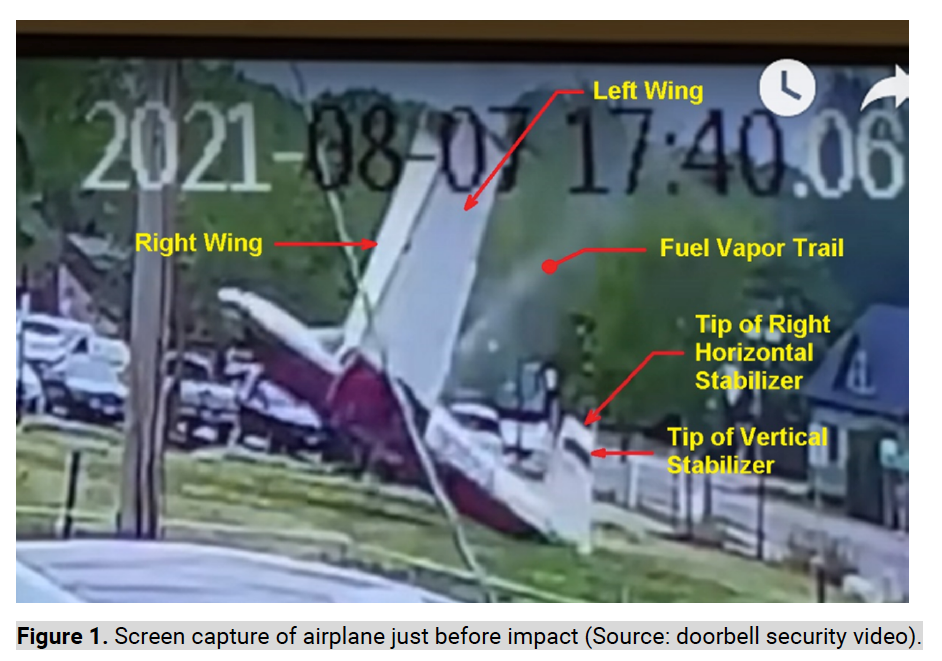NTSB Finds Cause of Mooney Structural Failure Crash
Three died in the 2021 loss-of-control accident, which was captured on a resident’s doorbell cam.

The National Transportation Safety Board (NTSB) has released its final report on the August 7, 2021, crash of a Mooney M20 in Victoria, Minnesota, that killed three. The plane was on an instrument approach when it went out of control and crashed, killing all three aboard, including the 72-year-old pilot and 40-year-old student pilot/passenger along with another passenger in the rear seating area.
As is the case with mishaps where the cause is not well known or only suspected, the NTSB's finding of probable cause reads like a description of the accident. That cause, according to investigators, was: "The pilot's loss of airplane control due to spatial disorientation during final approach, which led to a spiral dive that overstressed the airplane and resulted in an in-flight breakup." If there were some other reason the pilot lost control other than poor pilot technique, investigators were unable to determine it. In fact, they ruled out every possibility but pilot error.
Unlike in modern commercial airliners, which are required by law to have devices that record the aircraft's performance and systems parameters as it flies, small planes usually lack sophisticated data collection capabilities. Whereas when investigating the crash of an airliner, with small planes, investigators usually have to piece together other information such as the flight path and ground speed derived from radar/radar-like surveillance systems; the pilot's fitness to fly as gleaned from toxicology tests; or the condition of the wreckage of the plane, such as the scarring on a propeller, indicating whether the engine was producing power or not.
In this case, the condition of the airplane just instants before the impact was known, as the crash into a small field in a suburban area was captured on a resident's doorbell cam. That footage showed the Mooney, its wings and part of its tail folded upwards, descending at a very high rate and striking the ground and being destroyed. The crash was unsurvivable. How the pilot managed to lose control of the plane while it was in the clouds is unknown, but it is an all-too common fatal accident scenario.
In this case, there was much that was known, and as soon as the footage emerged, the pilot community reacted. Mooney M20 planes are known for their structural integrity---it is uncommon for a Mooney to experience structural failure in flight. But in this case, that is clearly what happened. The question on many pilots' minds was, why?
The reasons that aircraft go out of control are many, but one of the deadliest is when the pilot loses awareness of the plane's attitude and airspeed or for some other reason fails or is unable to correct the loss of control before the planes builds up a lot of speed. Successful recovery from such events, referred to broadly as "upsets," depends on several factors, including how much altitude there is available to recover, how fast the plane is traveling when the pilot recognizes the loss of control and the technique. In this case, the NTSB said the Mooney was both going far too fast while in a tight, descending turn, known as a spiral dive.
Once the pilot descended below the clouds---weather reports were that the ceiling was just over 1,000 feet above ground level---and gained visual awareness of the plane's severe nose-low/high-speed condition, the challenge would have been for the pilot to recover successfully from the upset. In this case, according to the report, it was probably already too late, as the plane was travelling faster than 180 knots (the highest speed called out in the report) and was in a very tight turn. The NTSB calculated that the plane was subjected to 8 Gs, a point at which it's possible/likely that occupants would lose consciousness. It is nearly twice the level of G force that the plane is certificated to be able to withstand with some deformation, and it explains why the pilot was unable to recover from the spiral dive, and why the plane's wings and tail folded. You can read the NTSB report on the crash here.

Subscribe to Our Newsletter
Get the latest Plane & Pilot Magazine stories delivered directly to your inbox






